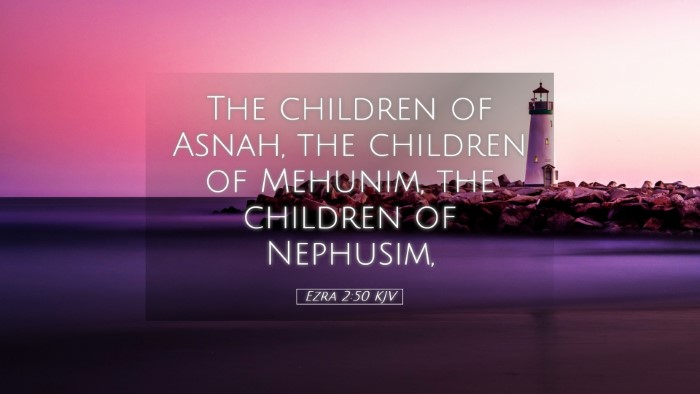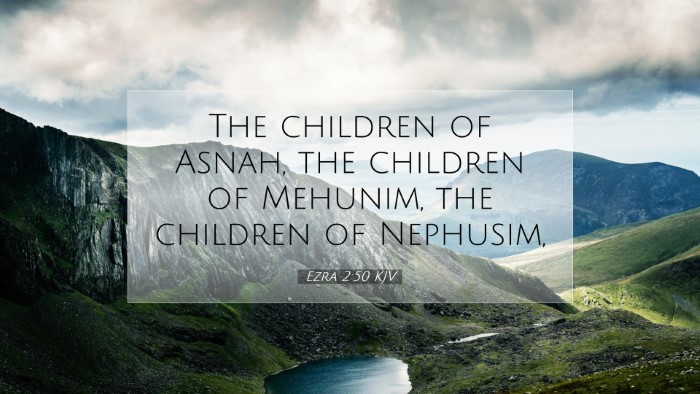Commentary on Ezra 2:50
Ezra 2:50 presents a list of inhabitants that returned from Babylon to Jerusalem, highlighting the various groups that formed the foundation of the rebuilding community. This verse is a part of a broader narrative focusing on the restoration of the Jewish people and their identity after the Babylonian exile. The analysis of this verse can help us unpack the theological and historical significance embedded within it.
General Context
The Book of Ezra primarily narrates the return of the Jewish exiles to Jerusalem after their captivity in Babylon. The period signifies a restoration not only of the people but also of their heritage, worship, and community identity. Ezra is central to these themes, tasked with re-establishing the Law and ensuring adherence to it.
Historical and Geographical Insights
Understanding the historical backdrop is crucial for interpreting Ezra 2:50. After the decree of Cyrus, the Persian king, many Jews returned to their homeland, and this chapter catalogs significant clans and individuals alongside their contributions to the rebuilding of Jerusalem. Notably, the names reflect a diverse societal structure, indicating a multifaceted community committed to God’s covenant.
Public Domain Commentary Insights
-
Matthew Henry's Commentary:
Matthew Henry emphasizes that lists like this one serve both a practical and theological purpose. They document God’s faithfulness in preserving His people through exile and returning them to their land. Henry remarks on the significance of each group mentioned, underscoring their roles in the work of restoration. He suggests that, while such genealogies may seem tedious, they reflect God’s meticulous attention to His promises and the continued importance of heritage among the people. The compilation of names is a testament to the individuals who left Babylon and the multitudes who sought to reestablish a life centric to worship and adherence to the Law.
-
Albert Barnes' Notes:
Albert Barnes provides considerable insights into the societal structure of the exiles. He points out that these returnees included priests, Levites, and families, indicating a holistic effort to restore the temple worship alongside rebuilding the city. His commentary suggests a wholeness in the approach to restoration: spiritually, socially, and legally. The mention of various groups underlines the importance of every individual's role in forming the community and participating in the sacrificial system introduced by God. Each member symbolizes hope and revival for future generations.
-
Adam Clarke's Commentary:
Adam Clarke discusses the significance of the names listed, commenting on the notion that they represent the 'living stones' in the proverbial temple that is being rebuilt. Clarke highlights the spiritual symbolism attached to such genealogical records – a reminder of the covenantal community that God cherishes. He encourages readers to reflect on the value of identity in Christ, suggesting that the community emerging from Ezra's efforts aligns with the fulfillment of God’s redemptive plans. Clarke's insights weave a narrative where physical restoration parallels the spiritual awakening of the people.
Theological Implications
This verse's content invites robust theological reflection. The act of recording names offers a glimpse into the nature of God’s people in restoration. Each name carries connotations of identity, belonging, and purpose, suggesting that collective memory plays a pivotal role in faith communities. The returnees are not merely numbers; they signify lives woven into the fabric of divine promise.
Covenant and Community
As God’s covenant people, the returning exiles embody His faithfulness. Their integration into a new socio-religious framework showcases the returning to covenantal fidelity. The list in Ezra 2:50 functions as an affirmation of identity and community responsibility, where each clan and family represents a commitment to God’s Law. The theological underpinning here pivots on the understanding that restoration requires a return to foundational principles established by God through Moses.
Applications for Today's Church
Pastors, scholars, and students can draw several lessons from this verse:
-
Identity in Christ:
Just as these exiles were defined by their lineage, Christians today find identity in Christ, representing a spiritual lineage that transcends earthly boundaries. The recognition of all members as part of the body of Christ elevates communal worship and collaboration in ministry.
-
Community Responsibility:
This passage underscores the importance of each member’s role in the community of believers. Each person contributes uniquely to the collective mission of the church. Leaders are encouraged to foster a sense of belonging and identity akin to what the early returnees experienced.
-
Remembering God's Faithfulness:
Like the exiles who remembered their historical narrative through genealogy, the church today must remember and recount the acts of God in their history. This remembrance fuels faith and inspires future generations to trust in the same God who restored His people in Ezra’s day.
Conclusion
Ezra 2:50 invites profound engagement with the themes of restoration, identity, and community. Through the lens of historical and theological insights from esteemed commentators, one can appreciate the significance of each name and the broader communal endeavor to return to God’s design. It encourages today’s church to embrace its identity within the narrative of God’s redemption and to recognize the vital role each member plays in fulfilling the missional call to restore and rebuild according to divine purposes.


